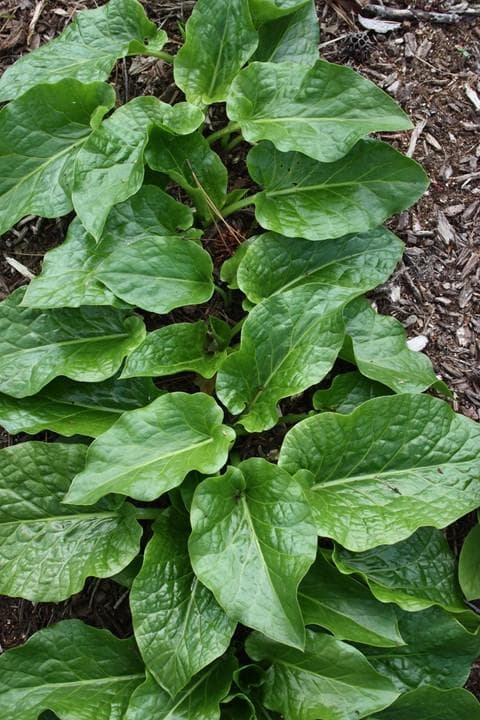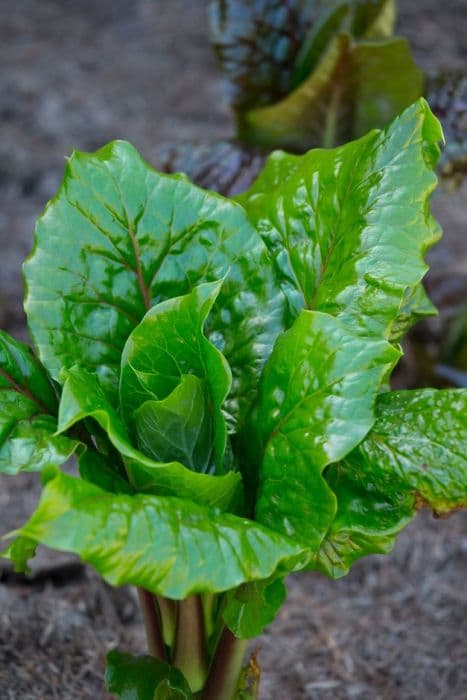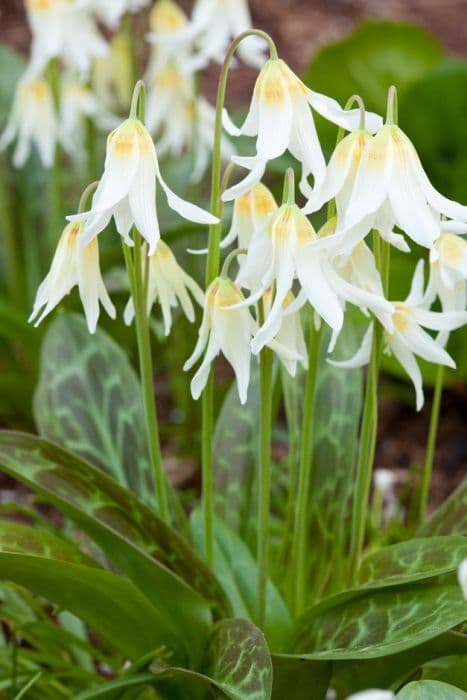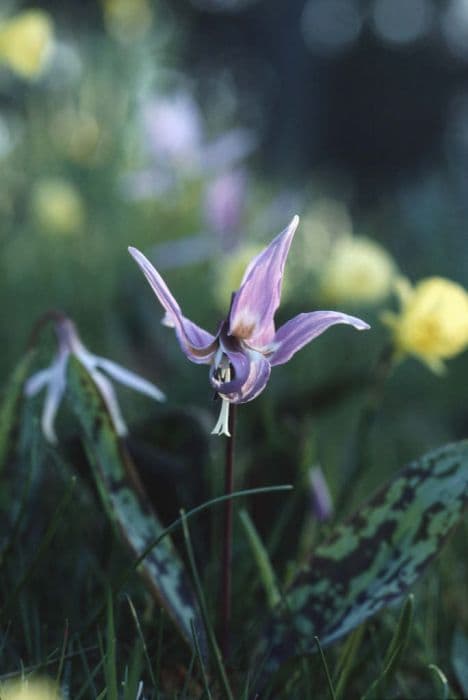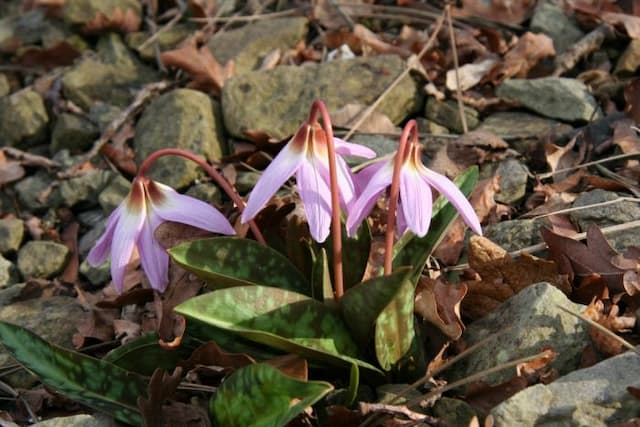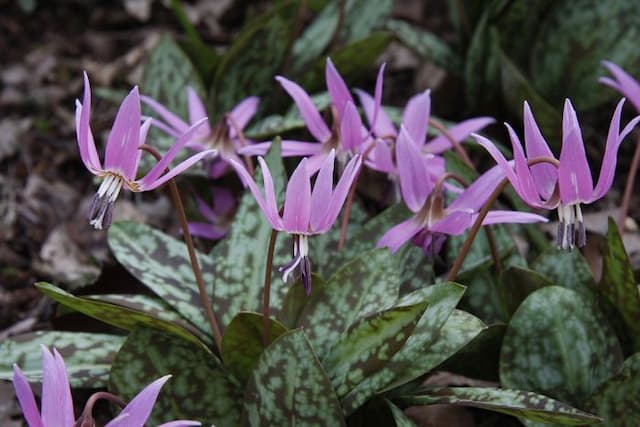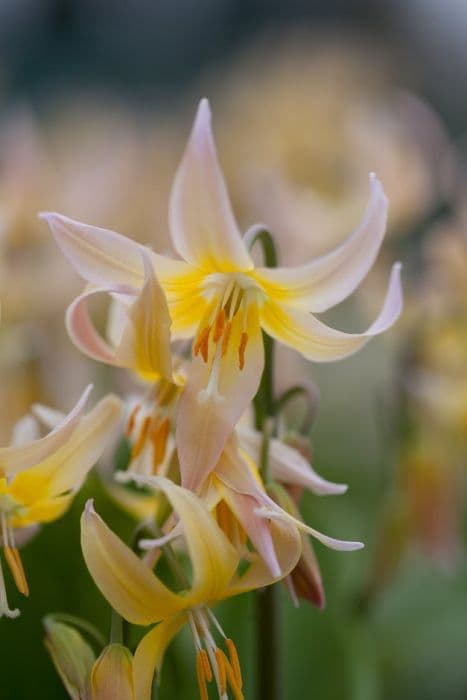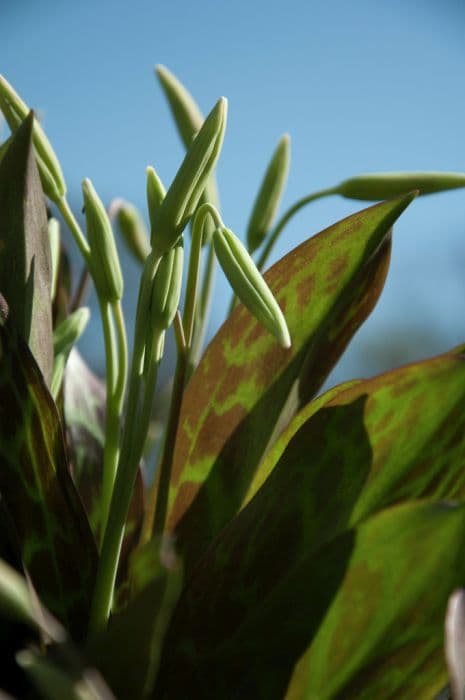Pointed Petal Fritillary Fritillaria acmopetala subsp. wendelboi

ABOUT
The plant with the common name Fritillaria acmopetala subsp. wendelboi showcases a very distinctive and eye-catching appearance. It features striking flowers that are bell-shaped and tend to hang downwards, almost as if they are nodding. These flowers come in a blend of colors, usually with a greenish-yellow base and adorned with a unique checkered pattern in purplish-brown hues that can sometimes appear as spots. The petals are slightly recurved at the tips, giving the blooms an elegant flared look. Inside the flowers, there is a set of protruding stamens which are usually a contrasting color to the petals, adding to their ornamental charm. The leaves of the plant are narrow, long, and glossy, with a lance-like shape that tapers to a point. They are typically arranged in a whorled or spiraled pattern around the stem that adds further texture to the already charming plant. The overall foliage is a lush green, providing a fresh backdrop that makes the remarkable flowers stand out even more. The plant exudes a natural grace that can become a focal point in any garden setting where it's grown, and it typically blooms in the spring, which adds seasonal interest to the landscape.
About this plant
 Names
NamesFamily
Liliaceae
Synonyms
Pointed-Petal Fritillary
Common names
Fritillaria acmopetala var. wendelboi.
 Toxicity
ToxicityTo humans
The plant commonly known as Fritillaria is not widely reported to be toxic to humans. However, many plant species can have individual variations and undocumented toxicities, so it is typically wise to avoid ingesting any part of plants that are not commonly recognized as food items. If any part of the Fritillaria plant were toxic, symptoms might include gastrointestinal distress such as nausea, vomiting, or diarrhea, as well as possible nervous system effects like dizziness or headaches. It is always important to exercise caution and seek professional medical advice if any plant is ingested and adverse symptoms occur.
To pets
Fritillaria is not commonly known to be toxic to pets. Nevertheless, as with humans, the toxicity of plants can vary, and caution should be exercised to prevent ingestion by pets, particularly because their smaller body sizes can make them more vulnerable to possible toxins. If a pet were to ingest Fritillaria and if it were toxic, symptoms might include vomiting, diarrhea, drooling, or more serious signs such as tremors or respiratory difficulty. If you suspect your pet has ingested this plant and is showing any signs of illness, contact a veterinarian immediately for advice and treatment.
 Characteristics
CharacteristicsLife cycle
Perennials
Foliage type
Deciduous
Color of leaves
Green
Flower color
Greenish-yellow
Height
1-2 feet (30-60 cm)
Spread
1 foot (30 cm)
Plant type
Bulb
Hardiness zones
7
Native area
Turkey
Benefits
 General Benefits
General Benefits- Ornamental Value - Fritillaria acmopetala subsp. wendelboi, commonly known as pointy-petal fritillary, is highly appreciated for its unique and attractive bell-shaped flowers, adding aesthetic value to gardens and landscapes.
- Biodiversity Support - It can support local ecosystems by providing habitat and nourishment for various insects, including bees and butterflies, thus contributing to biodiversity.
- Cultural Heritage - As a visually interesting and distinct plant, it can hold cultural significance and be part of traditional gardens or used in cultural ceremonies, contributing to heritage and traditions.
- Educational Interest - Botanical enthusiasts and students can study the plant’s interesting morphology and adaptive traits as part of environmental education programs.
- Pollinator Attraction - The flowers can attract pollinators, which is beneficial for the pollination of nearby plants and for maintaining a healthy and vibrant garden ecosystem.
 Medical Properties
Medical PropertiesThis plant is not used for medical purposes.
 Air-purifying Qualities
Air-purifying QualitiesThis plant is not specifically known for air purifying qualities.
 Other Uses
Other Uses- Fritillaria acmopetala, commonly known as the pointed-petal fritillary, can be used as a source of inspiration for artists and designers due to its unique checkered patterns and bell-shaped flowers.
- In horticulture, the pointed-petal fritillary is valued for its ornamental qualities and is often used to add visual interest to rock gardens and alpine garden settings.
- This plant is sometimes utilized in education and conservation programs to teach about plant biodiversity and the importance of preserving rare species.
- The pointed-petal fritillary can be used in photography, particularly macro photography, to highlight its intricate patterns and delicate structure.
- Florists may use dried specimens of the pointed-petal fritillary in their arrangements to provide an exotic and enduring embellishment.
- Due to its unique appearance, the pointed-petal fritillary is sometimes referenced in literature and poetry as a symbol of natural beauty and rarity.
- The plant can be included in biodiversity studies to monitor the health of ecosystems in its native habitat, providing insights into environmental changes.
- Pointed-petal fritillaries can be used in botanical illustrations and field guides as representative examples of the Fritillaria genus.
- In landscape architecture, the pointed-petal fritillary can serve as an example of how to incorporate bulbous plants into sustainable designs that require little maintenance.
- Culinary experimentation with the pointed-petal fritillary could explore the use of its non-toxic parts as an aesthetic garnish in gourmet dishes, though this is not a common practice.
Interesting Facts
 Feng Shui
Feng ShuiThe plant Fritillaria is not used in Feng Shui practice.
 Zodiac Sign Compitability
Zodiac Sign CompitabilityThe plant Fritillaria is not used in astrology practice.
 Plant Symbolism
Plant Symbolism- Uniqueness: The Fritillaria acmopetala subsp. wendelboi, commonly known as the pointy-petal fritillary, has a distinctive bell-shaped flower with unique patterning, symbolizing individuality and distinctiveness.
- Mystery: Pointy-petal fritillaries are less common and not as widely known, which imbues them with a sense of enigma and the symbolic meaning of mystery.
- Protection: Some species of Fritillaria are known to emit a scent that repels pests and animals, thus they can symbolize protection and natural defense mechanisms.
- Grace: The delicate and poised appearance of the pointy-petal fritillary's flower may symbolize gracefulness and elegance.
- Perseverance: As a plant that emerges from a bulb in the ground every year, it can be a symbol of resilience and the ability to overcome challenging conditions.
 Water
WaterFritillaria acmopetala subsp. wendelboi, known as Pointed-Petal Fritillary, requires moderate watering to maintain slightly moist soil. During the growing season, water it once a week with about 16 ounces of water per plant, being careful to avoid waterlogging as this can cause bulb rot. Decrease watering after the foliage starts to die back post-flowering, allowing the soil to dry out somewhat as the plant enters dormancy. During its dormant period in summer, minimal to no watering is necessary unless there are very dry conditions.
 Light
LightPointed-Petal Fritillary thrives best in partial sun to light shade. It is ideal to place the plant in a spot where it can receive morning sun and be protected from the intense sun in the afternoon. A location with dappled sunlight throughout the day is also suitable for this plant's light needs.
 Temperature
TemperaturePointed-Petal Fritillary prefers a temperate climate with temperatures ideally ranging between 50 to 75 degrees Fahrenheit. It may withstand slight frosts, but extreme cold below 20 degrees Fahrenheit can be harmful to the plant. During its dormant period in the summer, it can survive higher temperatures as long as the bulbs are not subjected to excessive heat.
 Pruning
PruningPointed-Petal Fritillary typically does not require regular pruning. However, after flowering has finished and the foliage begins to yellow, you can cut back the dead leaves. This usually occurs naturally, so pruning only serves to tidy the plant. Pruning is best done in late spring or early summer, once it's evident that the plant has entered its dormant phase.
 Cleaning
CleaningAs needed
 Soil
SoilThe ideal soil mix for Pointed-Petal Fritillary should be well-draining, comprising a mix of loam, sand, and compost to mimic its natural rocky environments. The ideal pH for this plant ranges from slightly acidic to neutral, around 6.0 to 7.0. Ensure good drainage to prevent bulb rot.
 Repotting
RepottingPointed-Petal Fritillary typically does not need frequent repotting. Repot every 2 to 3 years or when you notice the bulbs are overcrowded. The best time to repot is after the foliage has died back post-flowering season.
 Humidity & Misting
Humidity & MistingPointed-Petal Fritillary prefers moderate humidity levels that simulate its natural habitat; too high humidity is not recommended as it can lead to bulb rot. Aim for humidity levels around 40-50%.
 Suitable locations
Suitable locationsIndoor
Place in well-draining soil, indirect light, cool temp.
Outdoor
Well-draining soil, partial shade, protect from harsh sun.
Hardiness zone
7-9 USDA
 Life cycle
Life cycleFritillaria acmopetala subsp. wendelboi, commonly known as Pointed-Petal Fritillary, begins its life cycle as a seed that germinates in well-drained soil during autumn. After germination, it develops a bulb that remains dormant underground through the winter. In early spring, the bulb sends up a single stem, which bears lance-shaped leaves and one to a few nodding, bell-shaped greenish-yellow flowers with purple-brown markings. Following pollination, typically by bees, the flowers develop into a capsule fruit containing seeds. Once the seeds are dispersed, typically by wind, they complete the cycle by germinating in a suitable location. The parent bulb can also produce offsets, which contribute to clonal reproduction and help in spreading the plant.
 Propogation
PropogationPropogation time
Spring
Fritillaria acmopetala subsp. wendelboi, commonly known as Acmopetala fritillary, is predominantly propagated through bulb offsets, also called bulbils. These bulbils form around the parent bulb and are best separated and planted when the plant is dormant. This typically occurs in the late summer or early fall after the foliage has died back. To propagate, carefully dig up the bulbs and remove the offsets, which should be replanted immediately about 2 to 3 inches deep (5-7.5 cm) and spaced at least 3 inches apart (7.5 cm) in a well-draining soil mix. It is crucial that the new location receives adequate sunlight and is not waterlogged, as this could cause the bulbs to rot.
